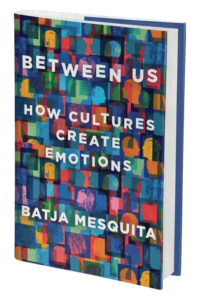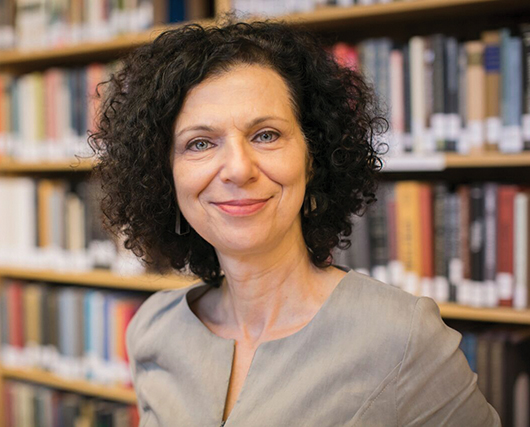 by Zoë Billington, User Research & Customer Insights, Santa Monica, California, zbillington@gmail.com
by Zoë Billington, User Research & Customer Insights, Santa Monica, California, zbillington@gmail.com
Zoë Billington speaks with Professor Batja Mesquita, a social psychologist, affective scientist, and pioneer of cultural psychology. She is a distinguished professor of psychology at the University of Leuven, Belgium, director of the Center for Social and Cultural Psychology at the University of Leuven, and author of the book Between Us: How Cultures Create Emotions.
Zoë: Let’s start with the 10,000-foot view of your career. Can you introduce yourself and share some of the experiences that have led you to where you are today?
Prof. Mesquita: There are so many ways to tell one’s life story, so I never know which narratives to include. When I was growing up, I thought I would be a psychiatrist because I wanted to help people. However, I was not lucky in the lottery for medical school in the Netherlands. Despite my grades, I didn’t get in. So, I started to study psychology, and I got really interested in understanding how the mind works in general. I took the research track in psychology to study the mind. My professor was writing a book on emotions at the time, and that’s how I started to research emotions. I also studied artificial intelligence for a while, but I ultimately ended up studying how people from different cultures experience emotions. When I say culture, it can be socioeconomic class, it can be ethnicity, it can be culture in the sense of national borders, or it can be generational.
Psychologists at the time were convinced that emotions were biological and universal. When I started my research, I was interested in whether there was anything about emotions that could be cultural. I soon discovered that the emotions of people from different cultures varied largely and that people also thought very differently about emotions. I found that the emotions in each culture played a central role in building the kinds of relationships that were valued and important.
Zoë: Wow, can you share an example to help illustrate this?
Prof. Mesquita: We’ve done a lot of research on anger and shame. What we find is that shame in many cultures is an emotion that can have positive outcomes. Not in the sense that it feels good; of course, shame is inherently not a good feeling. But positive in that it can do good things. In many cultures, shame is actually a moral, honorable emotion that makes you socially more acceptable. When shame is a good emotion in your culture, your own responses to shame become different, too.
Some of my colleagues studied shame in salesmen in the Philippines and in the Netherlands. In both countries, salesmen reported shame when they made mistakes in front of customers. But shame was an emotion that completely shut down the Dutch salespeople. They felt terrible, they withdrew, and they were no longer able to act appropriately in the relationship with the customer. Relatedly, their sales went down. For the Filipino salespeople, however, shame arose when something went wrong in the relationship, but to them, shame was a signal that they had to work harder to meet the expectations of the customer. As a result, they reached out to their customers and made an extra effort to smooth out the relationship with the customer. Perhaps, as a result of this, they reported that their sales went up.
Similarly, in research with young children, we find large cultural differences in the effects of shame. In some cultures, shame is seen as a positive emotion. Children are included and accepted when they show shame. In other cultures, many Western cultures included, shame reflects poorly on a child and is associated with exclusion.
In sum, shame has these very different connotations. But depending on the connotation, shame can run a very different course. You reach out, or you withdraw. Some respond positively, and others respond negatively. Depending on where shame takes place, it becomes a different phenomenon. You can, of course, find commonalities across cultures—it’s not that we don’t know at all what other people are talking about when they say they are ashamed. But what the emotion means and how it evolves is very different.
Zoë: Very helpful example, thanks. Going back to the story of how you came to do this research, is there anything else you’d like to add?
Prof. Mesquita: Another part of my story is that I have the experience of being in another culture myself. I grew up in the Netherlands. But as you can probably hear, I also spent quite a bit of time in the United States and in some other countries. Those years as an immigrant in the United States were very formative and showed me how much my emotions were tied to the culture where I grew up. When you move to another culture, your emotions don’t always fit the situations you’re in.
Zoë: Are there examples of these types of experiences you had in the United States that you could share?
 Prof. Mesquita: Well, I thought if I could learn the language, I could find my way around, and then I would more or less function. But I really felt out of place, and it was small things where it felt like I just didn’t know the script so much. In my book, Between Us: How Cultures Create Emotions, I call it the dance of emotions. When you dance a different dance than your partner, you end up stepping on each other’s toes. That’s sort of what happened. It was a lot of small things.
Prof. Mesquita: Well, I thought if I could learn the language, I could find my way around, and then I would more or less function. But I really felt out of place, and it was small things where it felt like I just didn’t know the script so much. In my book, Between Us: How Cultures Create Emotions, I call it the dance of emotions. When you dance a different dance than your partner, you end up stepping on each other’s toes. That’s sort of what happened. It was a lot of small things.
One example is when I had friends over for dinner. I didn’t know them so well, but it was a really fun evening, and it felt intimate and joyful. Then, at the end of the night, they thanked me for dinner—and I felt completely deflated. It was as if they rejected me. Because in the Dutch context, “thank you for dinner” is a sign of distancing. You would never say it if you felt really close to your host. In retrospect, I understand this better now. Americans—at least the Americans in my social, cultural environment—thanked me because they wanted to highlight my efforts as host. It didn’t rule out the evening being intimate or fun. I now thank my hosts for dinner, too.
This next example shows how emotions can be ways of doing or changing a relationship. In this case, the emotion of gratitude is making another person more important and singling them out for their special efforts. On the other hand, the kind of words that we would use in Dutch emphasize togetherness: having a really fun time together or celebrating our togetherness. They’re words that express a feeling of “we have been happy” rather than “I’m grateful.”
So, gratitude is doing something in the relationship. But similarly, other emotions are relationship acts. If I am angry at my partner, I’m basically saying that I’m not accepting their behavior, I think their behavior wasn’t very nice, and I’m entitled to better treatment. If I’m ashamed, I’m aware that I violated some norms, and I acknowledge the risk of being rejected or excluded. Shame may also imply the willingness to do something that fixes our relationship.
Now, if you think about emotions that way, you find that each type of emotion stands for a different way of conducting the relationship. But what those emotions mean is very different across societies and cultures. In my dinner party example, gratitude is usually valued in close relationships in the United States. In fact, there are many self-help tools based on this fact—where you have to remember on a daily basis how grateful you are toward your partner. It is possible that Dutch or Belgian relationships would also benefit from gratitude, but in those cultures, it would be more natural to emphasize closeness, intimacy, or the things that you enjoy together. So, the valued or expected ways of “conducting” a relationship are different than in the United States.
Zoë: Can you talk to me about how the discipline of psychology’s approach to understanding emotion and culture overlaps or differs from other social sciences that study emotion and culture, like anthropology or sociology?
Prof. Mesquita: At the start of my career, emotion research was actually kind of popular among anthropologists, too; several anthropologists wrote ethnographies of emotions in different, often very remote, cultures. Historians also studied emotions across the ages differently, and all of them found really big differences in emotions across cultures. But at the same time, psychologists kept finding evidence for the universality of emotions.
My first contribution to the field was a paper that tried to reconcile those different findings. At that time, anthropologists studied the emotions that were most commonly experienced and expressed in everyday life, whereas psychologists were interested in the human potential for emotions (e.g., can we all infer anger from the same facial behavior). I’ve since evolved from that point. I now think that many psychologists tried to study an ideal that does not exist—not in contemporary, Western cultural contexts, and even less so beyond those contexts.
The differences between anthropology and psychology are less big now. But their methods are different.
Anthropologists can tell you much more about a small piece of life in great detail. Anthropologists are usually immersed in the culture of their research, so they can see how emotions take place in everyday life. They observe when emotions actually occur, what people do in reaction to the emotion, and how emotions relate to other parts of life in that culture.
Psychologists have a different approach. They zoom in on the phenomenon of interest. Psychologists compare cultures, and they want to be certain that their findings in different cultures are comparable. Did we ask everybody the same question? Or if we give people the same tasks in the same way, what is the difference in their performance? Psychologists are more interested in the comparison and seeing how people would perform if you gave them the same task. While anthropologists are more interested in the tasks that people set for themselves or that a culture sets for itself.
The latest psychological research has also developed some methods that try to zoom in on life, but never to the same extent as an anthropologist. For example, we do what is called “experience sampling,” which means we ask people several times a day: How do you feel now? How did you feel when something emotional happened? What is it that you felt? Who was there? So, in psychological research, we can ask a lot of questions about emotions, too, but we still don’t follow people around the whole time, as anthropologists do.
Zoë: That sounds a lot like a diary study or a survey, which forms a great segue into my next question. As you know, our readers are researchers, consultants, in-house practitioners, UX specialists, academics, and more. What advice would you share with our readership about applying your findings about emotion and culture to their own research design, execution, and even analysis of data that might be coming from different cultures?
Prof. Mesquita: I can start with the big mistake that much of psychology has made. It’s the fallacy that it is enough to ask people in different cultures the questions you developed for Western target groups. A lot of the survey instruments out there have been developed for a very small, peculiar slice of the working world, and these methods are then exported to other cultures. It’s possible that you get the same answers if you use these surveys in different cultures, but in some cases, you do not probe for the most important feelings or sentiments in those other cultures. Or worse, you get answers that make no sense to that group of people.
If I asked you how frustrated you are by a product or experience, you can probably give an answer. But while frustration might be a big emotion in the U.S. workplace, it might not be so relevant in another country’s work context or in a specific segment of the work context.
Or another example, when I do research with youth, I want to know that I’m not using old words. Nobody says “disgusting” anymore in younger generations, so I need to be mindful of that. So, some of the things that you have to ask yourself about questionnaires are: Where were they developed? What were they meant to measure? Is there a way in which I can, for example, pilot the kinds of questions I want to ask in a more open-ended way to see if the answers are relevant for the group that I’m going to adapt the questionnaire for?
Another piece of advice is combining survey methods with interviews or observations so that you can get to the root of what the survey score actually means. For example, surveys on well-being found that high school-educated and college-educated people in the United States mean very different things. College-educated people who reported being well meant that they reached self-actualization, that they were challenged in their jobs, and that they had variety in their lives. But high school-educated people who were well meant that they or their family were not ill and that they were employed (not unemployed) and safe. So, you always want to check what your answers mean for different groups. Always ask why or observe their behaviors.
Lastly, keep in mind that sometimes people cannot report what you are looking for. There’s a tendency for researchers to ask their participants the questions they have. For example, let’s say there’s a business that can’t seem to retain their female employees. We can ask those females why they left. But their response might be something like, “I just didn’t see myself spending the rest of my life there.” As psychologists or researchers, we know that certain things matter but might be hard for participants to articulate. For example, female employees may not think to call out the fact that on the business’s website, there are very few images of women in leadership positions. Or they may not piece together the fact that they can never make it to the company happy hours—which happen when they have to go home to their children—makes them feel left out of the “club.” Does the woman fit in there?
Zoë: What are you working on these days? What are you most excited about?
Prof. Mesquita: I’m really interested in emotions in the multicultural society, and I’m working on two bigger questions.
One is if we move from one environment to another, how and when do our emotions change? Or when do they adjust or become attuned to the emotions of the host culture?
Applied to my own experiences, how did I learn to become grateful in situations that might not have called for the emotion in my original culture? How did I adjust to my American friends? To be sure, I did not pretend to be grateful. I did not think, “Oh, yeah, I’m in America; I should be grateful.” It’s really that I can now frame-switch and see that situation in another way than I used to. I’m interested in those processes. I’m interested in what changes and how it changes in people who are multicultural or who are moving between cultures in everyday life.
We know that people’s emotions do change and that exposure to the majority culture actually makes your emotions change more. We also know that majority people can adjust to a minority’s emotional norms if that minority norm is strong and there are many minorities in their environment. It certainly doesn’t have to be a one-sided process.
We’re also interested in what happens with your emotions when you live in two (or more) cultures. Do you become a blend—not fully fitting the emotional expectations of either culture but integrating the emotional expectations of both cultures? Or, alternatively, do you frame-switch—meaning you have different emotions when you are in one culture versus the other? Would I be more grateful in the U.S. than in the Netherlands, for instance?
There may also be differences between different biculturals. Some people may be more of a blend, and others may be frame-switching. I am unsure I can answer whether I am a blend or a frame-switcher.
Another cluster of questions that I’m interested in, and that’s probably really interesting for your readership, is how you can talk about emotions and understand emotions across cultural boundaries. We know that, on average, it takes about three generations before a group of immigrants is indistinguishable from the majority group. There are many people who experience and express their emotions in different ways than is the norm for the majority in a culture. We also live in a globalized world; there’s a lot of interaction between people from different cultures.
We are testing some interventions where we basically tell people in what ways emotions can be different across cultures. We hope these interventions give people the questions that help them understand the other person’s emotion (without necessarily having or knowing that emotion themselves). If we can foster a conversation or an interaction that leads to more emotional understanding, that’s a success.
The second issue I am interested in is how emotions in different cultures weave different relationships and interactions. Remember, I said before that, across cultures, particular emotions often mean something different, elicit different responses from other people, and form the core of different types of interactions or relationships. We are interested in the ways people at the workplace navigate emotional situations with each other. For example, when I’m a boss and have an employee in China, how are my emotional exchanges different from being a boss and an employee in Belgium or in the United States? But also, how are the emotional relationships of peers in each of these cultures different from the emotional relationships of employees and bosses? What can we learn from how people are expressing their emotions together?
Zoë: Those are some really interesting questions and certainly have implications for not only researchers and brands but really all humans managing their own relationships every day. I look forward to your next book on that. Thanks for speaking with us!
Interested in Learning More?
Read Susan Fader’s review of Between Us: How Cultures Create Emotions, found in the Summer 2023 issue of VIEWS. Susan says, “Between Us is a very thought-provoking book. It will help reframe your baseline assumptions about what is being conveyed by emotional cues, as well as the role of empathy.”



